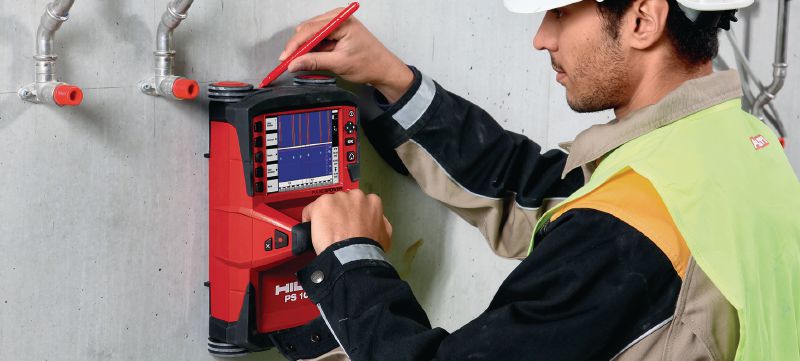Concrete Scanning: A Crucial Action Towards Guaranteeing Architectural Honesty and Safety And Security
In the realm of construction and facilities maintenance, the importance of concrete scanning can not be overstated. This precise process holds the crucial to revealing prospective dangers hidden underneath the surface of seemingly solid structures. By employing innovative modern technology and techniques, concrete scanning serves as a crucial tool in making certain that the honesty and safety and security of structures and bridges are upheld to the highest possible criteria. Nevertheless, beyond its surface-level effects, the role of concrete scanning extends much much deeper than satisfies the eye.
Relevance of Concrete Scanning
Concrete scanning plays a critical function in making certain the structural honesty and safety of structures and framework jobs. By making use of advanced innovations such as ground-penetrating radar (GPR) and electromagnetic induction, specialists can non-destructively examine concrete structures to detect possible problems, gaps, embedded items, and reinforcement design. This procedure allows very early detection of abnormalities that could endanger the security of a structure, protecting against expensive problems and ensuring the security of occupants.
Before drilling, cutting, or coring right into concrete, scanning aids determine the accurate locations of rebar, post-tension cables, and various other ingrained aspects, reducing the threat of unintended hits that can lead to architectural weaknesses. In addition, concrete scanning help in high quality control by verifying the density of concrete covers and identifying any kind of discrepancies that might impact the total longevity of the framework.
Innovation for Concrete Inspection

Benefits of Very Early Detection
Timely discovery of structural concerns can significantly alleviate risks and make sure the long life of construction jobs. By recognizing possible problems beforehand in the building procedure, stakeholders can take proactive actions to deal with issues before they escalate into larger and extra pricey troubles. Among the vital advantages of early detection is the avoidance of structural failures, which can present serious safety hazards and result in job hold-ups and financial losses.
Additionally, very early detection enables prompt repair work and upkeep, which can aid prolong the lifespan of the framework. By addressing concerns without delay, building teams can avoid costly repair services or also the demand for premature substitute of structural components. This positive method not just conserves money and time but likewise improves the overall security and sturdiness of the construction project.
Additionally, early discovery can enhance job planning and decision-making by supplying stakeholders with valuable insights into the problem of the framework. Equipped with this details, project supervisors can make educated selections concerning building and construction techniques, materials, and timelines, resulting in a lot more successful and efficient task outcomes.
Making Certain Structural Security
Ensuring the architectural stability of a construction job is paramount to its security and long life. Structural stability refers to the capacity of a structure or infrastructure to preserve its kind and feature under different loads and ecological conditions. To accomplish this, detailed assessment and monitoring of the structure are essential. Concrete scanning plays an important role in guaranteeing architectural security by identifying possible problems such as voids, delamination, or support deterioration that can endanger the stability of the structure with time.
By using sophisticated scanning innovations like ground-penetrating radar (GPR) and electro-magnetic induction, building and construction specialists can non-invasively check concrete structures to determine locations of concern under the surface area. This proactive method enables the early detection of weak points or issues, allowing timely fixings or reinforcement to avoid structural failings.
Normal concrete scanning throughout various building and construction phases and throughout the life process of a structure can assist preserve its stability, reduce threats, and ensure the security of passengers. By prioritizing structural stability via concrete scanning, building and construction tasks can boost their resilience and durability, ultimately adding to better safety and security and longevity.

Protecting Against Vital Failures
To guard versus disastrous occasions, careful tracking and aggressive upkeep are critical in averting essential failures within structural frameworks. Spotting possible issues prior to they rise is key to stop structural failures. Executing routine examinations, such as concrete scanning, can disclose surprise flaws like gaps, cracks, or corrosion that might compromise the honesty of a structure. By using sophisticated scanning go to these guys modern technologies like Ground Permeating Radar (GPR) or Concrete X-ray, designers can non-destructively analyze the condition of concrete and identify weak factors that need reinforcement or repair work - RainierGPR Service Areas.

Verdict
In verdict, concrete scanning plays a critical duty in guaranteeing structural integrity and security by utilizing innovative technology for early discovery of potential problems. This proactive technique helps protect against critical failures and ensures the security of frameworks. It is important to focus on concrete evaluation as a typical method to shield the longevity and security of structures and infrastructure.
Concrete scanning plays a crucial duty in making certain the architectural stability and safety of structures and framework jobs. Additionally, concrete scanning help in quality control by he has a good point validating the density of concrete covers and discovering any type of inconsistencies that may affect the overall sturdiness of the framework. Concrete scanning plays a critical duty in making sure structural stability by identifying prospective issues such as voids, delamination, or support deterioration that can endanger the honesty of the structure over time.

In conclusion, concrete scanning plays a vital duty in ensuring structural stability and safety and security by utilizing sophisticated modern technology for very early detection of potential problems.